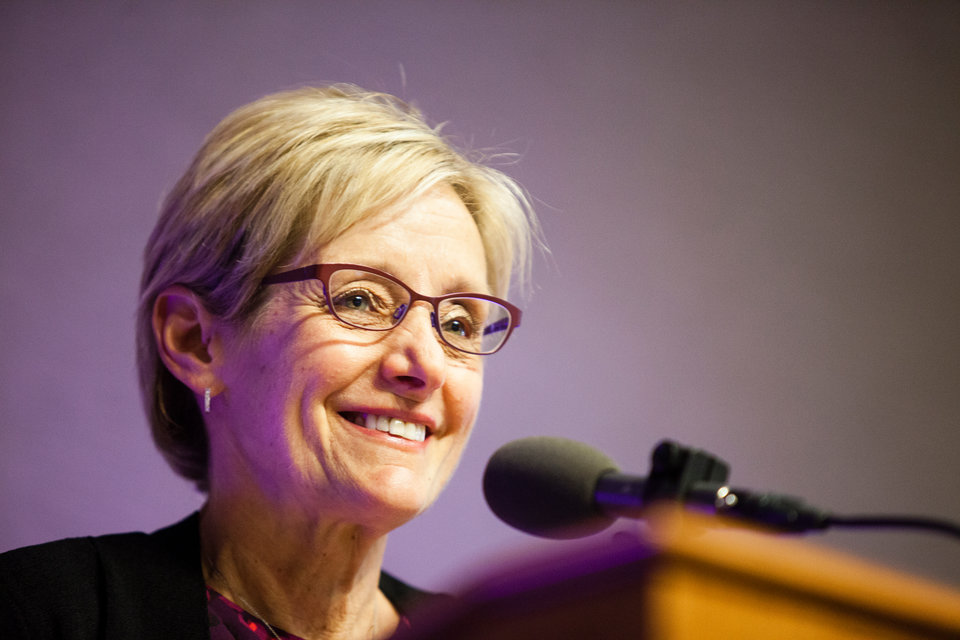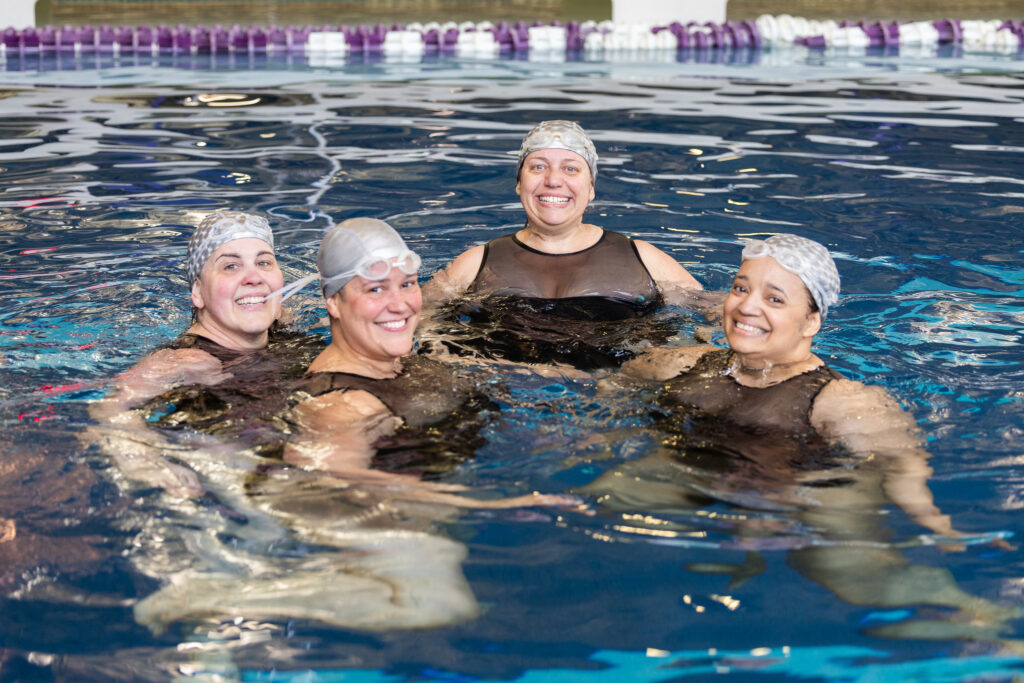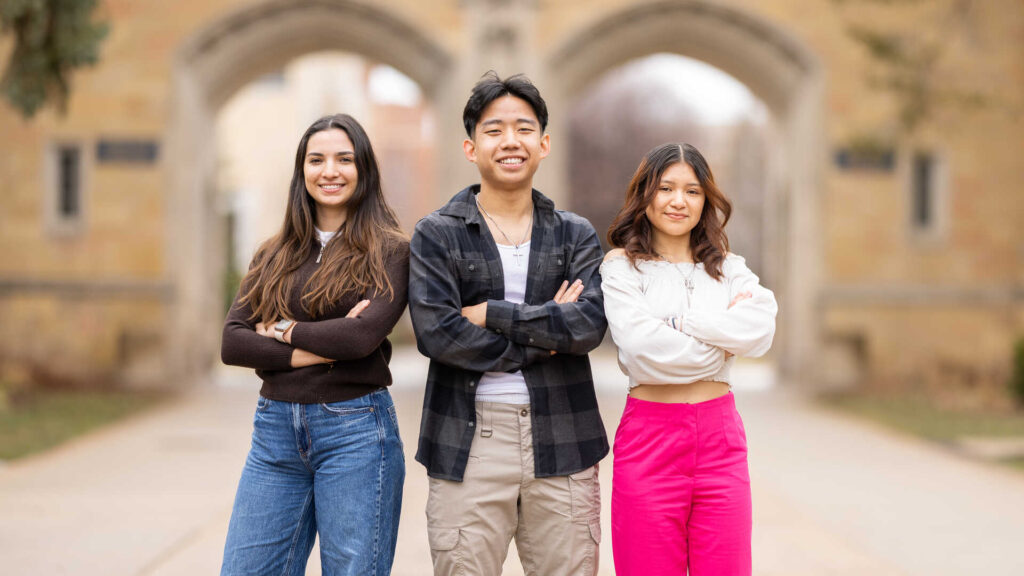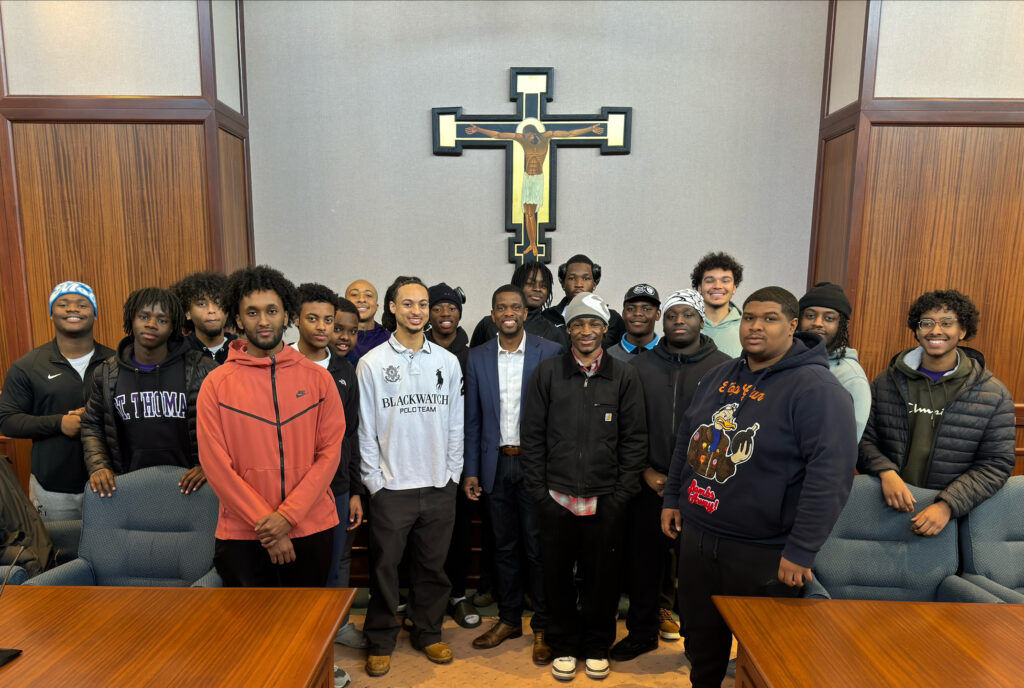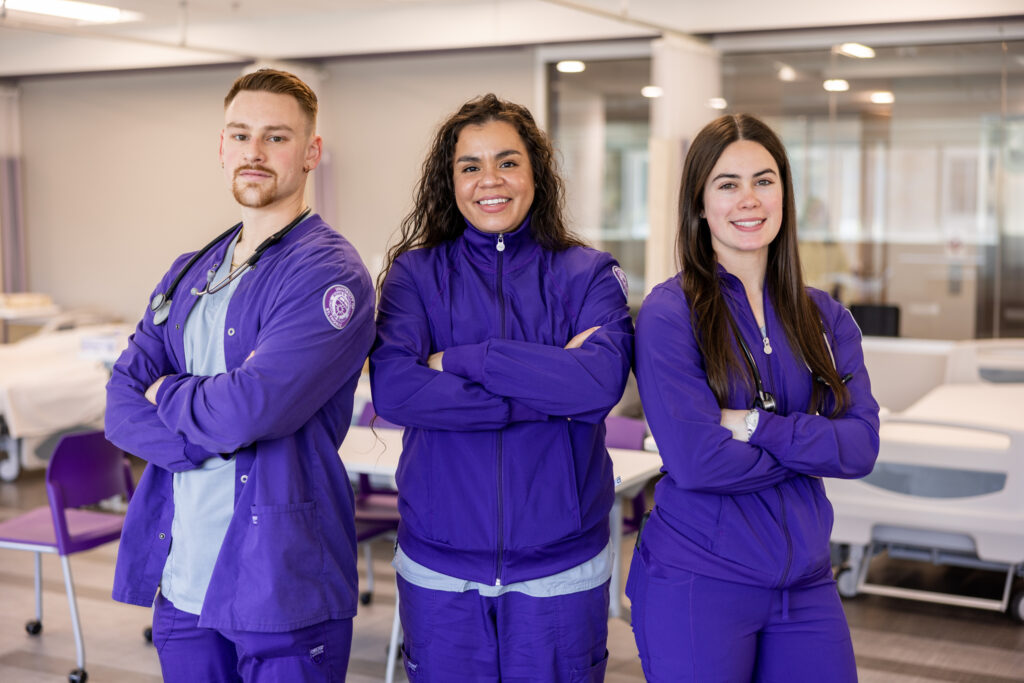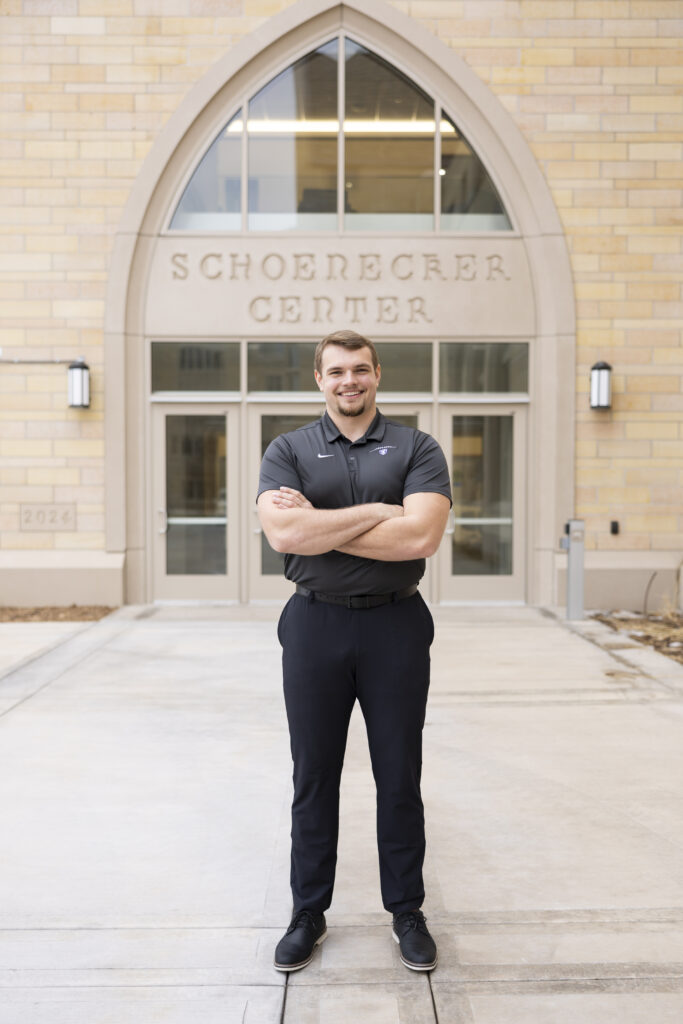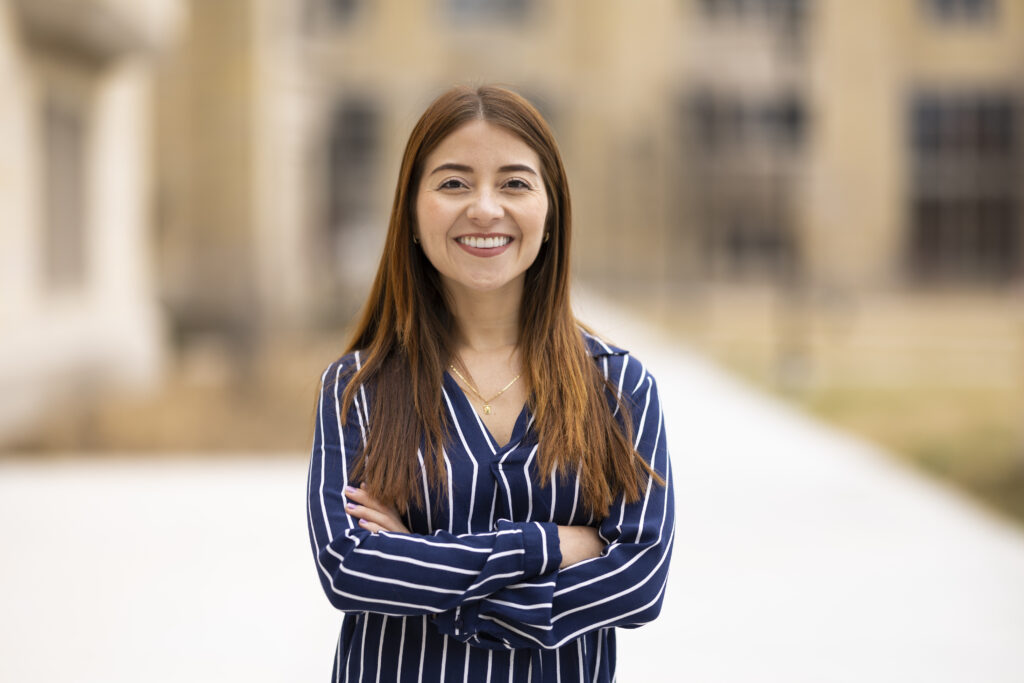Before I begin, let’s take a moment to acknowledge our deep history and connection to this land on which I am speaking today.
At St. Thomas we recognize and are grateful for the links we share with the Mdewakanton Sioux communities. We acknowledge that the land on which we stand is the ancestral land of indigenous peoples.
As a Catholic institution committed to justice and solidarity, we also commit to a journey of learning and acknowledging more about our past and our privilege. This includes acknowledging the land and its native people and our responsibility to work toward reconciliation.
Celebrating St. Thomas 2020
Again, thank you for taking the time out of your busy days and lives to come together.
This State of the University is a chance to celebrate our past, acknowledge where we are today, and look together to the future, to envision how St. Thomas will continue to flourish as its best self.
St. Thomas has always had a forward-thinking mindset. Since our founding by Archbishop John Ireland, we have been a place of innovation and change.
This calendar year marks the final year of St. Thomas 2020, the strategic plan that guided our work during the past five years.
We have much to celebrate thanks to the hard work of so many of you!
Rather than list new buildings and programs, let me highlight for you how this plan guided us in furthering our mission of advancing the common good, putting our students at the center of all we do, encountering the community and increasing access.
Advancing the common good
First, the plan helped us break down barriers.
Unequal access to a college education pervades our state and our society. Our strategic plan called us to find pathways that overcome those barriers.
Through the Dougherty Family College (DFC), St. Thomas provides a unique pathway to a four-year degree for young Minnesotans who face financial and social barriers yet have strong aspirations for college.
By 2027, about 70% of jobs in our nation will require at least a four-year college degree. And for Minnesota, that percentage is even higher. We want the holders of these jobs to represent the rich diversity of our state.
Last spring, we celebrated our first graduating DFC class. I am delighted so many of these inaugural graduates are now in their third year at St. Thomas!
As a university, we have renewed a deep connection to our mission by accompanying these students. These courageous scholars challenge St. Thomas to be a better St. Thomas, and our DFC alumni will play an important role in enhancing the future workforce of our region.
The strategic plan inspired St. Thomas to play an important role in closing Minnesota’s K-12 opportunity gaps.
Our renewed School of Education partners with school districts to help more school employees become fully licensed teachers, to increase the number of educators of color and to help all teachers develop multicultural understanding.
St. Thomas is taking a leadership role in ensuring that our K-12 educational system is equipped with teachers who can provide educational equity and excellence for all children.
The strategic plan propelled St. Thomas further into the health care space. Our society has an obvious demand for trained health care workers and a distinct need to change the way health care is provided. Currently, the United States’ health care spending makes up almost 20% of our gross domestic product (GDP). Employment market projections indicate that even if we double the number of nurses in Minnesota, we will not fill all the needs in our state for nurses. At the same time, incredible structural inequities exist in health care.
Our new Morrison Family College of Health will develop providers and leaders who address the integrated health needs of the whole person in the context of families and communities. It will disrupt the status quo in the health care system and tackle disparities.
Student success at the center
The plan further inspired us to put students at the center of all we do, for which I am always grateful!
The plan guided us to respond to the increasing mental health needs of our students by opening the Center for Well-Being.
A growing number of students begin college with a mental health issue, and the newness of college can magnify these challenges.
One barrier to getting help is the fractured care system. National studies show that only 10% of patients follow through on a mental health referral when that service is in a different facility than the referring health provider. Having to go from one building to another for care is often a major barrier to seeking help.
Working alongside Undergraduate Student Government, we took a bold step to combine primary and mental health services, so every student can be treated holistically. The Center for Well-Being also addresses many other wellness factors such as sleep, nutrition, stress, anxiety, spirituality, physical activity, violence and substance abuse.
It creates an environment where all students can achieve their full potential as healthy, happy, flourishing and fulfilled individuals.
We put students first when we revised and modernized our undergraduate curriculum last year. This work takes important steps:
- to set our students up for success while they’re at St. Thomas and when they graduate.
- to help our students see how all the elements of our curriculum fit together into a coherent whole.
- and to provide increased flexibility for our students, while ensuring they continue to have a robust liberal arts experience.
I want to thank everyone in our community who is contributing toward implementation efforts – from faculty who have devoted countless hours to developing new courses and opportunities, to staff who are working behind the scenes on all of the logistics it takes to bring our new curriculum to life. This effort calls on all of us to say “we’re in” – we’re going to help make this happen.
Thank you, again. I look forward to seeing the new curriculum continue to develop.
We are also putting students first by creating a deeper engagement and holistic experience for our first- and second-year students.
Our new residence halls will open this August, and improvements are in process for Ireland, Brady and Dowling Halls. For the first time ever, we will have sufficient quantity and quality living spaces to enable all first- and second-year students to live on campus. Thus, beginning in fall of 2021, we will initiate a two-year residency requirement. Studies show that on-campus residency increases the use of academic and student support services, strengthens students’ connections to other students, faculty and staff and fosters a stronger sense of belonging on campus.
This residency requirement will only be effective, however, if the option of living on campus is within financial reach for more students.
Kanthak Scholars Program
Today, we are announcing the Kanthak Scholars Program. Thanks to a $20 million generous gift from a recently deceased 1959 alumnus, Irv Kanthak, the university will be awarding tuition and housing grants to select incoming students who have high financial need.
The new fund will provide $10,000 per year for the first two years, when students live on campus, and $5,000 for the remaining two years for tuition.
The Kanthak gift also will allow us to set aside $50,000 per year for students experiencing emergency financial hardship throughout the year. It will be used to assist students who face unexpected life experiences that too often force them to drop out.
The gift also creates an alumni referral scholarship to attract students with financial need from areas outside of Minnesota. This is a first-of-its-kind effort at St. Thomas.
Creative scholarships that reduce affordability barriers for our students are our No. 1 fundraising priority. Two years ago, we established a goal of doubling our scholarship endowment by the end of 2025, and we are already about 50% of the way there.
Encounter with community
St. Thomas 2020 guided us to significantly broaden experiential learning opportunities for students through the creation of the Center for the Common Good. This portal connects our students to experiences that permanently alter the way they engage in the community and accompany the marginalized.
Pope Francis talks often of the need for encounter, and urges us to face one another, as Jesus encountered the poor and the suffering. At St. Thomas, we are called to go to the margins of society, to where we might be uncomfortable, and to do our part to make life better for others.
The Center for Common Good’s initiatives support over 3,000 unique students who have contributed over 80,000 hours with over 260 approved nonprofit and faith-based partners in our community.
We are looking forward to hosting the Ashoka U Exchange in April, a global conference where our faculty, staff and students will share best practices and new research, as well as learn about new techniques to educate and engage our students and community.
We are also promoting encounter with others through the College of Arts and Sciences’ SOLV initiative.
Archbishop John Ireland was deeply engaged in the social issues of his time; he wanted his students to be active participants in public life and to think outside the walls of the classrooms to transform the world.
SOLV brings interdisciplinary big thinkers (i.e., professors, students and community members) together to partner to find solutions to real community challenges.
In this climate of great uncertainty and angst in our political discourse, St. Thomas can be a much-needed voice for collaboration and reason across different perspectives.
Most recently, the college announced the development of Minnesota’s first arm of Ready to Run®, a nonpartisan campaign training program to encourage women to run for elective office or position themselves for appointive office.
Increasing access
Ensuring that current and future Tommies can afford St. Thomas is absolutely essential.
Today, many under-resourced and underrepresented students and families and their school advisers do not consider St. Thomas as a viable option. They often perceive us as inaccessible, too expensive and out of reach.
We are enacting two significant policy changes to open the opportunity to a St. Thomas education to more under-resourced students.
First, we are reforming how we award financial aid. Previously, we awarded aid amounts to students primarily based on their academic credentials without regard to their financial need. Beginning with the students matriculating this fall, we are expanding our initial award criteria to include both factors and thus, providing more aid to students with deeper financial challenges.
And, beginning with the students matriculating in the fall of 2021, I am pleased to announce that we will become a “test-optional” university! This means that we will be creating a more holistic system of analyzing our applicants, and relying more heavily on other indicators, like high school grade-point average, rigorous course selections, and out-of-class and service activities.
Does this mean we are lowering our academic standards? No. It means that we are acknowledging the overwhelming research evidence that wealthier students generally fare better than less wealthy students on the ACT and SAT. We recognize that a standardized test is not the best predictor of college success and can be a barrier for some. We will spend more time and effort with each applicant, taking some of the bias out of the process, and identifying applicants who are the best fit for success at St. Thomas.
Capturing our momentum
So much has been accomplished as a result of our 2020 strategic plan!
It has guided us to change and grow in accordance with our mission and to prepare for what’s next. Thank you, thank you, thank you for this incredible work!
Our accomplishments show that we are a university full of momentum, delivering on the promise of our mission: Inspired by the Catholic intellectual tradition, we are preparing morally responsible leaders to think critically, act wisely and work skillfully to advance the common good.
At St. Thomas, our strategic plans do not sit on a shelf!
St. Thomas 2025
Now, we as a community must embark on developing our next strategic plan and together develop a refreshed vision and shared goals.
I urge you to take part in important discussions about the future aspirations and priorities of the University of St. Thomas for the next five years.
The Strategic Planning university-wide task force invited all students, faculty and staff to participate in St. Thomas 2025.
Your voice is needed in the current strategic planning survey, as well as in stakeholder sessions which will be held throughout March.
On the front page of OneStThomas, you can find the St. Thomas 2025 logo and link to how to weigh in and take the survey.
I urge you to take the opportunity to fill out the survey and attend the stakeholder sessions to hear from and learn from others.
Please share your opinions, energy and good ideas.
St. Thomas 2020 was so successful because you created it, and you owned it.
To maintain our momentum, we must continue working together as one university.
Challenges and uncertainties
Let me take a moment to describe our rapidly changing environment and openly address the challenges before us and how we as a community are confronting them.
St. Thomas is not immune to the shifting higher education landscape. Demographics are changing. The number of high school graduates is declining, particularly in the Midwest, and the financial need of high school graduates is increasing.
We also are dealing with other uncertainties, such as:
- To what extent will future students seek traditional, face-to-face education?
- What will be the impact of the rhetoric we hear about free college?
- How will our society value higher education?
According to a Gallup poll conducted in June 2018, only 48% of U.S. adults expressed “a great deal” or “quite a lot” of confidence in higher education. This was down from 57% in 2015. In fact, Gallup reported that no other institution type nationally has shown a larger drop in confidence over the past three years than higher education.
- Can we find a better way to help families realize that higher education is worth it, and find more ways to help them afford it?
- Will graduate programs be able to attract students to their traditional programs? What kind of education will post-college adults demand?
These challenges and uncertainties naturally stir fear and anxiety.
Yet, I am confident, and I am optimistic.
Why?
First, I am optimistic because higher education is an incredibly valuable proposition, and I am confident that a St. Thomas education positions our graduates for a lifetime of success.
Based on a recent report by Georgetown University’s Center on Education and the Workforce, it’s clear that a St. Thomas education is worth the cost. After accounting for the cost of completing an undergraduate degree, the years invested in finishing the degree instead of working and the interest costs of student loans, a typical St. Thomas undergraduate will benefit financially over their career by well more than $1 million. In fact, the estimate is $1,142,000. This puts St. Thomas in the top 6% of the more than 4,500 public and private schools in the study.
I also am confident because we are proactively working to prepare for and adapt to this inevitably changing environment.
Embracing change
I know the pace of change we are implementing at St. Thomas is making some feel overwhelmed and perhaps ask: Who are we? Who are we trying to be? Where are we going?
Who are we? We are a student-centered, Catholic university with a powerful mission and a focus on academic excellence. Our academic excellence relies on our outstanding faculty, liberal arts foundation and relevancy to the rapidly changing world of work. Inspired by our Catholic mission, we prepare values-based students and alumni committed to advancing the common good. And our students are at the center of all we do.
We are not trying to be anything else. We are adopting best practices to continue strengthening ourselves along these dimensions.
Where are we going? We are taking our well-earned, outstanding reputation in Minnesota to a larger geographic footprint to tell our story. This is critical to our future of sustaining a robust demand for a St. Thomas education.
Our pace of change is rapid. However, when you step back and look at the changes (e.g., flat tuition, need-based financial aid, test optional, residency requirement, and more integrated and flexible curriculum), these are all well-documented, student-centered and academically excellent best practices. They improve student access, retention and graduation rates. These are not pioneering or risky changes. They have been implemented with documented positive outcomes for decades at schools similar to us. In a sense, we are leapfrogging, and this can be seen as drastic and jarring. However, these are not changes we can delay. We must do them now to position ourselves for continued success as a student-centered university.
We also are continually evolving our operations to find better and less costly ways to deliver the services that support our students’ education.
We must be vigilant stewards of our resources at St. Thomas and always remember that they primarily emanate from student tuition and donor gifts.
Managers have been asked to do some hard work, to proactively find savings and make hard budget choices. I recognize and appreciate this work and know it emanates from your strong commitment to this university.
We will continue to find ways to improve and standardize our processes, incorporate data and technology, and break down silos and integrate operations where it makes sense.
The theme of many of our operational changes will continue to keenly focus on whom we are serving, i.e., students, employers, alumni or communities, and meeting them where they are. We will have to continue to integrate across academic and nonacademic departments to best do this.
We have made modest strides in finding new sources of revenue and continue to vigorously pursue this.
And our fundraising is outpacing our competitors. Donors want to invest in our students’ potential, and they are choosing to invest in St. Thomas because of our strong mission and bold approach.
My ask of you as a university community (i.e., students, faculty and staff) is to acknowledge our reality, embrace change as the new normal (knowing how difficult this is) and recognize that each and every one of us must be part of continually adapting St. Thomas and ensuring we remain relevant, vibrant and impactful.
Our Strategic Planning process will help us look to the future and envision how St. Thomas can continue to flourish as its best self.
It will help us answer the question:
How are we, as one St. Thomas, furthering our mission and progressing toward our longer-term aspirations?
I want our community to embrace a vision for St. Thomas – an aspiration that helps describe the opportunities at our doorstep.
Vision
Looking out 10 years, I believe that St. Thomas can be described as:
“Widely recognized for forward-thinking, values-based education and inclusive excellence, the University of St. Thomas is a premier Catholic institution for learning, studying and work and a partner of choice for communities and organizations from the local to the global.”
Let me break down some important phrases in this aspiration.
Widely recognized
We are at an inflection point. Our evolution over multiple decades from a small men’s college to a comprehensive university has brought us to this moment, and we are taking our place among the widely recognized Catholic universities in the country.
Today, we have a strong reputation, particularly in Minnesota. In 10 years, we will be more widely recognized across the country for our strengths.
We are known for academic excellence and the quality of preparation of our alumni. Our law school has increased the visibility of St. Thomas by accomplishing one of the best placement rates in the country – 84% of our graduates are in “gold-standard” jobs. In the latest Princeton Review ranking of law schools based on judicial clerkship placements, St. Thomas was No. 4 in the country, one spot behind Yale University.
We are known for our impactful mission of advancing the common good as demonstrated by initiatives such as the Center for the Common Good, our Ashoka U designation and the Under-Told Stories Project.
A huge opportunity at our doorstep to increase our reputational visibility is through athletics. As you know, we have received an invitation to join the Summit League at the Division 1 level.
By joining the Summit League for the majority of our sports, along with the Pioneer League for football and separate men’s and women’s hockey leagues, we will expand the geographical reach and exposure of St. Thomas.
Tommies competing at this level across a broader geographic footprint will expand the platform from which we tell our story of academic excellence, strong preparation of our alumni and impactful mission. It will enhance our reputation and further cement St. Thomas’ place among our national peer and aspirant schools. If you look at the 16 private, Catholic universities ranked above us in one of the most prominent national rankings, U.S. News & World Report, all compete in Division I athletics. Across the country, the vast majority of schools who are most similar to St. Thomas in size, scope and mission, compete in Division I. And they all use athletics as a platform to tell their story.
Yes, this is an investment we are making. It will cost more in travel, scholarships and support staff. It also will generate more revenue. (It already has.)
In sum, I am very confident that this investment will be appropriately sized and paced to be digestible financially, that we will continue to emphasize the “student” in the student-athlete and that this move will increase our reputation overall – and academically – and will further extend our mission across a national stage.
Forward-thinking
We have a responsibility to be forward-thinking in preparing our graduates for the rapidly changing world of work. We must be externally focused and anticipate the needs of the communities and employers we serve. At the same time, we must integrate across our academic disciplines and operational silos and bring the holistic best of St. Thomas to the table to prepare our students and serve our communities and employers.
A great example of forward-thinking innovation at St. Thomas is our creation of a new Center for Science, Engineering and Arts on south campus.
Our School of Engineering has listened to employers and reacted to provide collaborative engineers who think holistically.
The new center will infuse innovation and entrepreneurship into collaborative workspaces for students from multiple disciplines to work together with each other and the community on problems that matter. In fact, we are co-developing the complex and its programs with employers and other partners.
Values-based
We have always been values-based, and our Catholic mission continues to infuse our curriculum and priorities.
We educate students to be morally responsible leaders. We don’t just say it, we do it across all parts of the university.
We are inspired by our Catholic faith to graduate leaders who are guided by a moral compass. Across the board, our curriculum emphasizes ethics. And the new Center for Principled Leadership at the Opus College of Business extends this focus beyond the university and helps business leaders to think globally, act ethically and create enduring value for society.
We are also guided by our catholic faith to care for the planet. Pope Francis’ encyclical, Laudato Si’: On Care for Our Common Home, calls us to care for our planet and for all people by protecting the environment.
The Holy Father’s call guided our work to create St. Thomas’ first strategic plan for sustainability, a plan that leads us to carbon neutrality by 2035. With a STARS Silver rating and recognition as one of Princeton Review’s Green Colleges, St. Thomas currently offers 95 courses that address sustainability from over 80% of our academic departments. We are infusing sustainability in the First-Year experience course and offering deeper connection for students through an Environmental Sustainability learning community.
The Pope’s words inspire us to act now. He said, “The young remind us that the earth is not a possession to be squandered, but an inheritance to be handed down. They remind us that hope for tomorrow is not a noble sentiment, but a task calling for concrete actions here and now.”
Inclusive excellence
You have heard me say this many times, and I will keep repeating that we are embracing a long-term journey toward inclusion. With intentionality and full focus, and greater participation than ever before, we are prioritizing diversity, equity and inclusion and working to make St. Thomas a more welcoming community for all.
Last year, we launched the Action Plan to Combat Racism. These commitments remain front and center and will not be put on the back burner. So many in this room have stepped up to make this work a priority. From scrutinizing our hiring practices, to creating more opportunities for dialogues about race in and out of the classroom, to creating welcoming spaces for students to gather, to ensuring effective counseling support, to making it easier to report bias, there is so much ongoing work and commitment. And we can’t stop.
I want to share explicitly my personal commitment to this work. I will seek to further understand and acknowledge my own privilege, as well as the institutional racism that exists at St. Thomas and in our society. I will continue to demand that inclusion be front and center in our university decisions. I will go to uncomfortable spaces and continue to learn and grow as an individual and continue to support your learning and growth. I will listen deeply to every member of our community. I will give you the grace to make mistakes, and I will continue to encourage every member of our St. Thomas community to do this work and take part in our journey.
Dismantling racism is one way that we are fulfilling our Catholic commitment to ensuring the dignity of every human being.
I also would like members of our St. Thomas community who identify as LGBTQ+ to know that I am committed to nourishing a community that exhibits respect, compassion and sensitivity toward you. I acknowledge the dignity in each of you as a precious human being. It is because we are Catholic that we are called to accompany and respect the dignity of all.
I am convinced that we – the University of St. Thomas – cannot thrive as a community without our constant collective and intentional work toward diversity, equity and inclusion in the broadest sense. We must be welcoming across any category we use to identify ourselves, whether it be race, sexual identity, political persuasion, neurodiversity or any other category.
Premier Catholic institution
Sustainability is just one example of the urgency of our catholic mission.
Now, more than ever, our Catholic foundation is essential for our future and responsive to the needs of the global society.
We live in a world prone toward consumer mentality, directed by immediate gratification and too often dedicated to pursuing individual good.
Our nation is stressed by nationalism and racism, and there are far too many disparate voices and too much distrust.
We are living in a pessimistic time, and people are searching for something that transcends the demands of daily living.
In short, the world is seeking joy and inspiration.
The Catholic intellectual tradition calls us to advance the common good, to advocate for truth, beauty and transcendent value and to affirm human dignity in all of our interactions. It calls us to listen deeply to, dialogue with and accompany one another.
We are developing leaders grounded in the Catholic intellectual tradition who can practice critical compassion and thoughtful love.
The world needs voices of ethical reflection.
The world needs hospitality and young people who are trained to provide for the needs of others.
Because we embrace and integrate our Catholic mission, St. Thomas students provide joy and inspiration and bring light to our world in need.
Partner of choice
St. Thomas is poised to be the partner of choice for our business, nonprofit, local and global communities.
To be a partner of choice, we must flip the lens and deeply understand what our partners need from us. We must turn around the traditional way of thinking. Instead of providing individual degrees and asking employers to adapt; we must understand and anticipate what our partners need and respond with relevant learning programs, often co-created with them. We must create educational content, experiences and spaces alongside our partners and ensure that our graduates meet the most current and future needs of employers.
The Opus College of Business, for example, is implementing new delivery models and integrating digital technologies into its curriculum. With support from the GHR Foundation, Opus will launch a “Digital Commons” where faculty, students, and corporate partners co-create learning experiences that prepare students for business in a digital world. As Corie Barry, the CEO of Best Buy, reminded us during our recent First Friday alumni luncheon, data is the new currency of business. It is the tool that is fueling better decisions and innovative products.
We also are launching a new university platform to offer noncredit courses through Continuing and Professional Education, or CAPE. Recognizing that there is a continual need for “upskilling” in today’s rapidly changing world of work, St. Thomas will offer noncredit courses to develop the new skills that our alumni and the broader market are demanding.
Closing
In closing, I want you to know that I am grateful for each and every one of you. I am so appreciative of, and inspired by, our journey together, and I am excited about the next chapter.
I am amazed at this caring community who truly shows me time and again that you want the best for our students.
Uniquely human talents and traits, such as compassion, interpersonal communication, empathy, ethical frameworks and creativity, are key to the health and success of any organization.
By that measure, no one surpasses St. Thomas!
Whatever St. Thomas looks like in the next five, 10 or 20 years, we will not stray from our mission of preparing morally responsible leaders to advance the common good.
We will put the welfare of students first and embrace ideas and solutions that will ensure a bright future for the University of St. Thomas.
In a rapidly changing world driven by problem-solvers and those with a strong liberal arts foundation, St. Thomas has never been more important and more relevant as a leader in the future of higher education.
We are grounded in a strong foundation and ready to embrace our next chapter, extending the reach of our mission and impact across the country and throughout the world.
My optimism about St. Thomas has never been brighter!
Archbishop John Ireland’s spirit still guides us when he says:
“I seek no backward voyage across the sea of time; I will ever press forward. I believe that God intends the present to be better than the past, and the future to be better than the present.”
Now, I am pleased to share with you a video summary of our remarkable St. Thomas voyage across the sea of time! Thank you!
